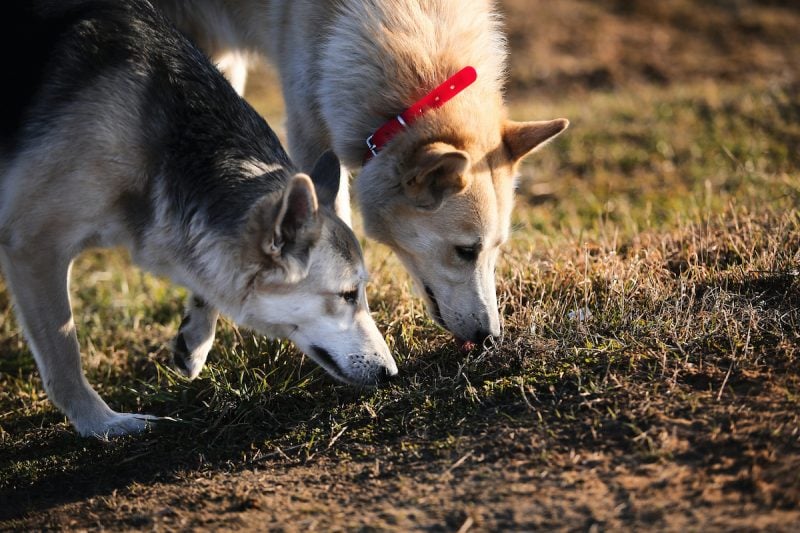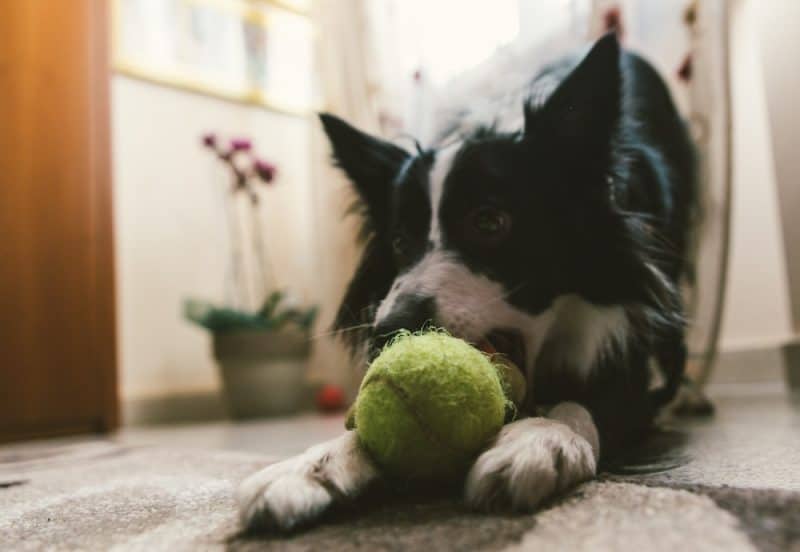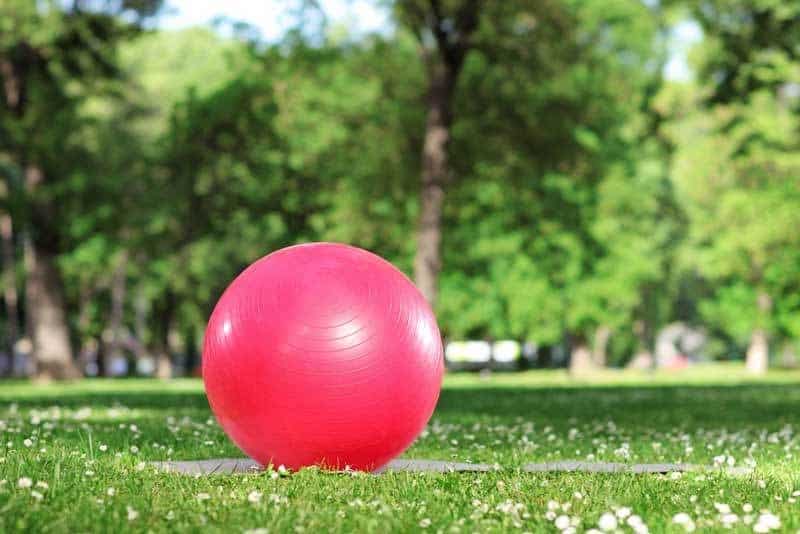Naomi surged forward, straining at the leash. Nearly an hour into our rainy hike, the young German shepherd still had boundless energy. We needed another strategy to wear her out. But with an injured hip and dog aggression issues, Naomi wasn’t a candidate for many of my favorite exercise strategies. What to do?
When we got home, I shook out my shoulder and sat down to make a plan. After that fateful walk, I created a list of exercises to do on walks that help burn off energy and build skills for challenging dogs. I call them “activity walks” and recommend them for many of my clients.
Spicing up your morning walk is a great way to burn off excess energy in dogs. The great thing about these modified walking exercises is that they don’t take extra time or energy on your part, but they can really wear even a high-octane pooch out!
Benefits of Switching to an Activity Walk
Your morning walk with your dog is usually a cornerstone of your routine together — whether you like it or not. Even if you’re tired or it’s pouring rain, you have to hit the pavement to get Fido out to potty before you go off to work.
But your walks with Fido can (and should) be so much more than a cursory bathroom break.
Using these strategies to spice up your morning walk will turn your run-of-the-mill AM routine into a much more enjoyable and exciting daily adventure.
Depending on what type of activity walk you choose, the benefits of switching up your morning walk may include:
Extra energy burn off. A quick jaunt around the block won’t put a dent in the energy level of many dogs (ask my border collie Barley). Almost every dog owner will benefit from having a slightly more tired pooch at the end of the day!
Solidify obedience skills. Playing training games during your walk is a great way to help your dog learn to listen to you in distracting situations. This is a lifesaver in some cases, and a great way to prep for the Canine Good Citizen exam!
Soothe nervous dogs. Some dogs, especially those that live in the concrete jungle, get stressed out by their daily walks. Changing up how you walk your dog can really help reduce this stress and ease your dog’s anxiety around outdoor walks!
Improve your dog’s fitness. Playing around with urban agility is a great way to build up your dog’s balance, body awareness, and overall fitness. This is especially helpful if you’re interested in trying canicross, practicing treibball, or exploring some nearby hikes.
Build your relationship. It’s easy to get disconnected from your dog if you’re flipping through your phone while your pup checks the “pee-mail” of the neighborhood. Switching to a different type of morning walk can help refocus you on each other.
No extra energy on your part. Most activity walks don’t take much extra time or energy on your part. That makes them a great way to pack a punch when you’re busy, tired, or even sick!
Since different walk activities result in different benefits, I recommend switching it up! Try creating a unique routine each week, pull ideas from a hat before you leash up, or pick a walk “type” depending on your needs for the day.
Activity Walks A-Z: Exploring Your Options & How to Begin
Here are a few of my favorite types of activity walks, and what they can do for you.
Activity #1: Urban Agility
Skip the class fees and teach your dog to use the environment as his own agility course.
- Tools Needed: Leash, treats.
- Time Budget: Built into your daily walk.
- Benefits: Builds body awareness, teaches new skills, burns energy.
How-To: Bring treats on your walk. As you find park benches, jungle gyms, or signposts, start teaching your dog to interact with these items.
Start by teaching your dog “up” by luring him onto something with a treat. You can easily teach him “off” by tossing a treat away. You can later teach your dog to go over and under park benches, or even loop around sign posts!
Later, you can use your pup’s skills as a foundation for agility or as a way to get your pup out of the way. This activity walk is fairly training intensive at first, but you can easily work it into most daily routes.
The video below serves as a great example of what urban agility looks like:
Activity #2: Heeling Practice
Build up your dog’s ability to walk in a tight heel position using a fun heeling game.
- Tools Needed: Leash, treats.
- Time Budget: No more than a few minutes per walk.
- Benefits: Teach your dog a flashy heeling behavior. Build focus in training and improve your relationship.
How-To: Teaching your dog a formal competition heel (where your dog walks touching your left leg and looking up at you) is incredibly difficult. If that’s what you’re into, Denise Fenzi’s blog on precision heeling and online courses are hands-down the way to go.
For the purpose of this activity walk, I simply start rewarding dogs for being closer and closer to my left side during the walk. You’re not necessarily aiming for a formal heel, but you might get something close!
Inject intense sessions of rewarding your dog for a tight heel while letting your dog play and sniff – heeling is very mentally taxing for your dog, so don’t overdo it. As your dog gets better at this, start injecting more direction changes and play during the walk.
Here’s a video of Denise Fenzi playing some heeling games with her dog Lyra.
Activity #3: The Backwards Morning and the Treasure Hunt
Reduce stress in your dog’s life by doing your morning routine right.
- Tools Needed: Puzzle toys plus whatever you normally need for your morning routine.
- Time Budget: Same as your normal morning routine.
- Benefits: Help your dog love being left alone and feel better about you leaving for work.
How-To: Start out your morning with the stuff that’s most boring to your dog. Go to the bathroom, read the newspaper, eat breakfast, and get ready for work before you walk your pup. If your dog absolutely needs to go out right away, take him out quickly and then go back inside to finish preparing for your day.
Once you’re all ready for work, head out on your morning walk. I recommend pairing this with a Scavenger Hunt Walk (see below). When you get back from the walk, put your dog away for a moment – I use the bathroom, but a crate or other room will do just fine.
Now, rather than pouring his food into a bowl, things get interesting. Pour your dog’s food into a few different puzzle toys and pull out some edible chew toys, like Greenies dental chews and pig’s ears. Then, hide these toys all over the house. Make it easy at first, and avoid hiding your pup’s breakfast anywhere near human food – you don’t want her to learn to steal.
With so much to do and so much to eat, most pups won’t even notice you’re leaving the house! This won’t be a cure for dogs with true separation anxiety, but is a great way to help prevent separation anxiety from developing.
See a video of me demonstrating the “Backwards Morning” here.
Activity #4: Scavenger Hunt Walks
Teach your scaredy-dog that the neighborhood is full of hidden goodies and tap into your pup’s nose.
- Tools Needed: Treats.
- Time Budget: 5-15 extra minutes before your walk.
- Benefits: Boost confidence in scared dogs by teaching them they can find hidden treasure along your walks. Sniffing also helps give your dog a mood boost, doubling the impact of searching for hidden food! Burn off excess energy in high-energy dogs.
How-To: Initially, you’ll need to teach your dog the basics of nosework (sniffing for hidden treats) in the comfort of your home. From there, you’ll gradually build out to having your pup search for treats in the yard.
Head out with a few treats in hand, leaving your pup at home. Hide the treats in easy spots at first, close to your home. You’ll have to make this ultra-easy with really nervous dogs, but can build up the difficulty based on your dog’s skill and confidence. Give your dog his search cue (generally the word “search”) and let him lead!
Your dog should already understand the game of nosework, and is now learning that he can sniff and find goodies during your daily walk. It’s basically an Easter egg hunt for your pooch!
Activity #5: Training on the Road
Build your dog’s obedience skills in distracting environments.
- Tools Needed: Treats.
- Time Budget: A few extra minutes per walk.
- Benefits: Polish behaviors to impress a crowd – or even save your pup’s life.
How-To: Bring treats on your walks and start practicing obedience commands while on the go.
If your dog doesn’t already sit at crosswalks or walk nicely on leash, start with these skills. The mental energy and focus will help burn excess energy, even as you’re creating a better-behaved pup.
Once your dog has mastered these skills, start randomly practicing other skills. I like to tell Barley to lie down sometimes, while I keep moving — this is really hard for most dogs. Mixing obedience training into your walks will keep your pup’s focus on you while he learns to listen in difficult situations.
Activity #6: Decompression Sniffing
Let your dog lead the way, sniffing and exploring the world. This walking method was pioneered Sarah Stremming of Cognitive Canine.
- Tools Needed: A back-clip harness and leash that’s over 10 feet long (I like this long line). Avoid flexi-leads, as they teach your dog to pull in order to get where he wants to go. If your local laws allow it and your dog is rock-solid off leash, you can skip the equipment and walk off-leash.
- Time Budget: At least 40 minutes. Ideally, you’re going to take your dog to a large local park or hiking trail for this – escape the concrete jungle!
- Benefits: Give your dog time to sniff and explore on his terms. Let him relax and decompress while teaching him that he’s allowed to make his own decisions and lead the way sometimes. This is great for reactive dogs and shy dogs that struggle with confidence.
How-To: Decompression walks are meant to be calming for your dog. He’s supposed to get to lead and sniff.
There’s no “right” way to do it, but in general, your dog will be on a long line (or off-leash, if it’s safe and legal for your dog).
Go at your dog’s pace and let him lead and sniff. You don’t have to interact much – this is your dog’s time. If your dog is really jazzed to pull at first, that’s ok – just keep walking until he chills out. Then walk at least as long as it took for him to calm down again, so that he really gets that decompression time. That means that if it takes 20 minutes for Fido to stop pulling, you should walk an additional 20 minutes before going home (for 40 minutes total). Let your dog sniff and explore!
When Spiced Up Walks Won’t Be Enough
Some dogs are really go-go-go. An activity walk alone will not be enough to wear out many dogs.
This is especially true for young dogs, herding dogs, hunting dogs, or even bully breeds. If you’ve got a high-energy dog in your home, plan on looking into a variety of training games to meet your dog’s exercise needs — or consider buying a pair of running shoes and a hip leash.
Failing to give your dog enough exercise is a recipe for disaster. An activity walk is a great way to start or end your day with your dog, but it often won’t be enough on its own.
For my border collie Barley, an activity walk is a great compliment to a trail run, agility class, afternoon hike, or skijoring excursion. If he’s well exercised from the day before, I can often get away with nothing more than a long activity walk – but I don’t count on it!
How do you spice up your dog’s morning routine? We want to hear your ideas!








Leave a Comment